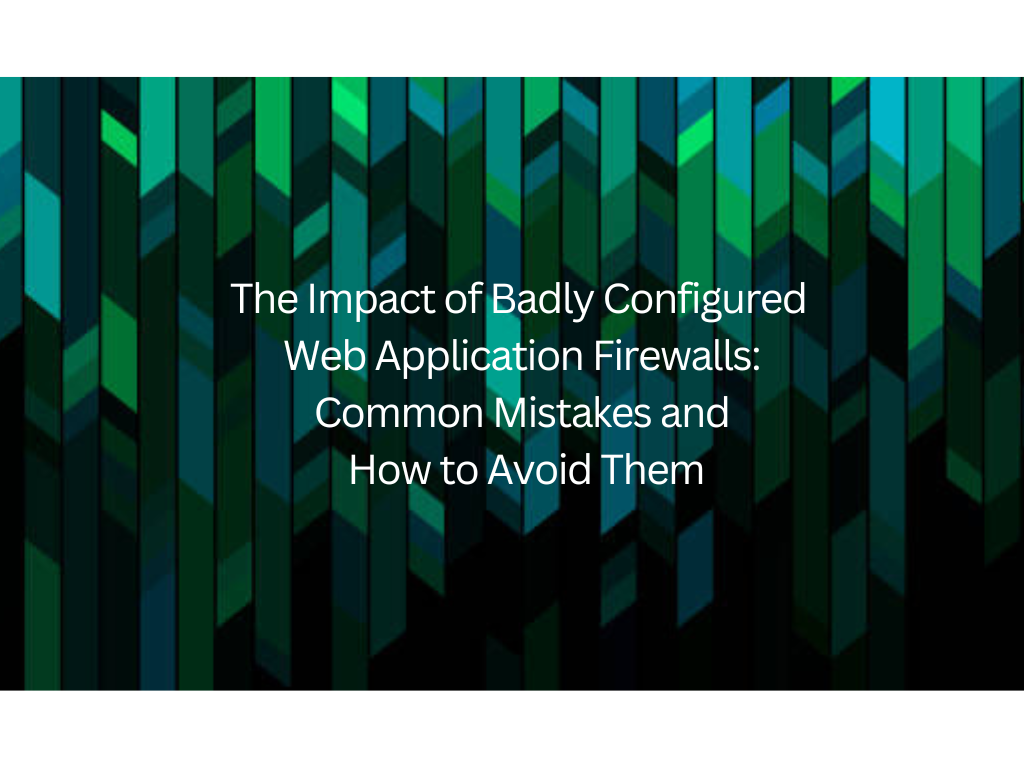Web application firewalls (WAFs) are a critical security solution that helps protect web applications from various cyber threats. However, the effectiveness of a WAF depends greatly on its configuration. Poorly configured WAFs can result in common mistakes that have severe consequences for the security of web applications. In this blog post, we will explore the impact of badly configured WAFs, and common mistakes organizations make, and provide tips on how to avoid them.
Common Mistakes in WAF Configuration
- Relying on Default Settings: One common mistake is relying on default settings when configuring a WAF. Default settings may not be suitable for the specific web application being protected and can be easily exploited by cybercriminals. Organizations should avoid this pitfall of convenience and take the time to properly configure their WAFs according to the security requirements of their web applications.
- Improper Rule Configuration: Another common mistake is improper rule configuration. WAFs use rules to determine what traffic is allowed or blocked based on predefined criteria. Organizations may make mistakes in defining these rules, resulting in false positives or negatives. For example, overly strict rules may block legitimate traffic, while overly permissive rules may allow malicious traffic to pass through. Regular review and update of rules are essential to ensure their effectiveness.
- Lack of Regular Updates: Failure to regularly update WAFs with the latest security patches and updates can leave them vulnerable to emerging threats. Cybercriminals are constantly evolving their attack techniques, and WAFs need to be updated accordingly to detect and prevent these evolving threats. Organizations must prioritize regular updates and patch management for their WAFs to minimize the risk of successful attacks.
- Inadequate Monitoring: Inadequate monitoring of WAFs can result in a blind spot in an organization’s security posture. Without proper monitoring, organizations may miss critical alerts or fail to detect ongoing attacks. Regular review of logs, reports, and traffic patterns is crucial to identify any suspicious activity and take prompt action to respond to potential attacks.
Consequences of Badly Configured WAFs
The consequences of badly configured WAFs can be severe and far-reaching. Organizations may face various consequences, including:
- Successful Attacks: Poorly configured WAFs may fail to detect and prevent web application attacks, resulting in successful breaches. Cybercriminals can exploit vulnerabilities in web applications and gain unauthorized access to sensitive data or disrupt the normal functioning of web applications. This can lead to financial loss, reputational damage, and legal liabilities for organizations.
- Data Breaches: Inadequate WAF configuration can result in data breaches, where sensitive data such as customer information, intellectual property, or financial data is exposed or stolen. Data breaches can have severe consequences, including financial penalties, reputational damage, and loss of customer trust.
- Regulatory Non-Compliance: Many organizations are subject to industry-specific regulations that require them to implement proper security measures, including WAFs, to protect sensitive data. Failure to properly configure and maintain a WAF can result in regulatory non-compliance, leading to fines, legal actions, and reputational damage.
- Loss of Business Opportunities: Reputational damage resulting from a successful attack or data breach can lead to a loss of business opportunities. Customers may lose trust in the organization’s security measures and choose to do business with competitors. This can result in financial loss and long-term negative impacts on the organization’s bottom line.
How to Avoid Common Mistakes in WAF Configuration
To avoid the consequences of badly configured WAFs, organizations should follow best practices for WAF configuration, including:
- Custom Configuration: Avoid relying on default settings and customize the configuration of your WAF to suit the specific security requirements of your web applications. This may include defining rules based on the type of traffic, source IP addresses, user agents, and other relevant criteria.
- Regular Rule Review and Update: Regularly review and update the rules of your WAF to ensure their effectiveness. This includes identifying and removing outdated rules, updating rules based on emerging threats, and fine-tuning rules to minimize false positives or negatives. Regular rule review and update should be part of your ongoing security maintenance routine.
- Patch Management: Keep your WAF up-to-date with the latest security patches and updates. This includes not only the WAF software but also any underlying operating systems, libraries, or plugins that may be used in conjunction with your WAF. Regularly check for updates and apply them promptly to keep your WAF protected against known vulnerabilities.
- Monitoring and Alerting: Implement proper monitoring and alerting mechanisms for your WAF. Regularly review logs, reports, and traffic patterns to detect any suspicious activity. Set up alerts to notify you of potential attacks or anomalies in WAF traffic. This proactive approach can help you detect and respond to potential threats before they result in successful attacks.
- Testing and Validation: Test and validate your WAF configuration to ensure its effectiveness. Conduct regular penetration testing or vulnerability assessments to identify any weaknesses or loopholes in your WAF configuration. Fix any identified issues promptly to strengthen your WAF’s security posture.
- Training and Education: Provide adequate training and education to your IT and security teams on WAF configuration best practices. Ensure that your team members are knowledgeable and skilled in configuring, managing, and monitoring WAFs effectively. Regularly update their skills and knowledge to keep up with evolving threats and best practices.
Conclusion
Properly configuring a web application firewall is essential for effective web application security. Badly configured WAFs can have severe consequences, including successful attacks, data breaches, regulatory non-compliance, and loss of business opportunities. To avoid these consequences, organizations should follow best practices for WAF configuration, including custom configuration, regular rule review and update, patch management, monitoring and alerting, testing and validation, and providing adequate training and education to IT and security teams. By taking these measures, organizations can strengthen their WAF’s security posture and protect their web applications from potential threats. Don’t overlook the importance of WAF configuration and prioritize it as a crucial part of your overall web application security strategy.




